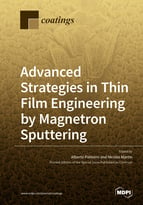Advanced Strategies in Thin Film Engineering by Magnetron Sputtering
A special issue of Coatings (ISSN 2079-6412).
Deadline for manuscript submissions: closed (31 October 2019) | Viewed by 44739
Special Issue Editors
Interests: thin film growth; atomistic processes; porous thin films; oblique angle deposition; magnetron sputtering; physical vapor deposition
Special Issues, Collections and Topics in MDPI journals
Interests: physics of metallic and ceramic thin films; reactive sputtering; glancing angle deposition; electronic transport properties
Special Issue Information
Dear Colleagues,
Recent years have witnessed the flourishing of numerous novel strategies based on the magnetron sputtering technique aimed at the advanced engineering of thin films, such as HiPIMS, combined vacuum processes, the implementation of complex precursor gases or the inclusion of particle guns in the reactor, among others. At the forefront of these approaches, investigations focused on nanostructured coatings appear today as one of the priorities in many scientific and technological communities: The science behind them appears in most of the cases as a "terra incognita", fascinating both the fundamentalist, who imagines new concepts, and the experimenter, who is able to create and study new films with as of yet unprecedented performances. These scientific and technological challenges, along with the existence of numerous scientific issues that have yet to be clarified in classical magnetron sputtering depositions (e.g., process control and stability, nanostructuration mechanisms, connection between film morphology and properties or upscaling procedures from the laboratory to industrial scales) have motivated us to edit a specialized volume containing the state-of-the art that put together these innovative fundamental and applied research topics. These include, but are not limited to:
- Nanostructure-related properties;
- Atomistic processes during film growth;
- Process control, process stability, and in situ diagnostics;
- Fundamentals and applications of HiPIMS;
- Thin film nanostructuration phenomena;
- Tribological, anticorrosion, and mechanical properties;
- Combined procedures based on the magnetron sputtering technique;
- Industrial applications;
- Devices.
Prof. Dr. Alberto Palmero
Prof. Dr. Nicolas Martin
Guest Editors
Manuscript Submission Information
Manuscripts should be submitted online at www.mdpi.com by registering and logging in to this website. Once you are registered, click here to go to the submission form. Manuscripts can be submitted until the deadline. All submissions that pass pre-check are peer-reviewed. Accepted papers will be published continuously in the journal (as soon as accepted) and will be listed together on the special issue website. Research articles, review articles as well as short communications are invited. For planned papers, a title and short abstract (about 100 words) can be sent to the Editorial Office for announcement on this website.
Submitted manuscripts should not have been published previously, nor be under consideration for publication elsewhere (except conference proceedings papers). All manuscripts are thoroughly refereed through a single-blind peer-review process. A guide for authors and other relevant information for submission of manuscripts is available on the Instructions for Authors page. Coatings is an international peer-reviewed open access monthly journal published by MDPI.
Please visit the Instructions for Authors page before submitting a manuscript. The Article Processing Charge (APC) for publication in this open access journal is 2600 CHF (Swiss Francs). Submitted papers should be well formatted and use good English. Authors may use MDPI's English editing service prior to publication or during author revisions.
Keywords
- Magnetron sputtering
- Nanostructures
- Growth mechanism
- Functional properties
- HiPIMS







